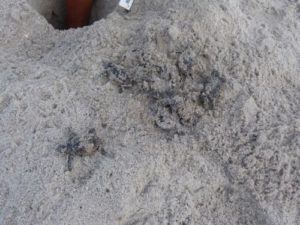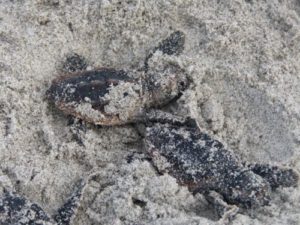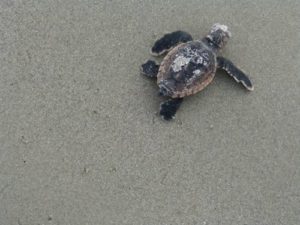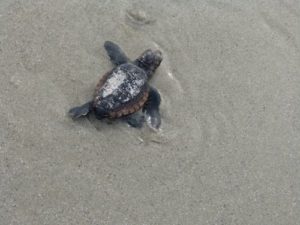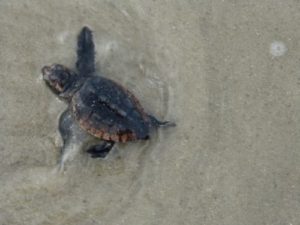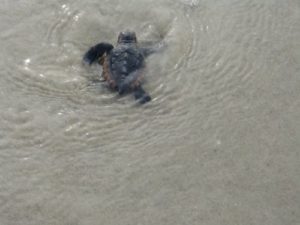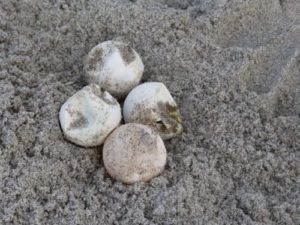I thought the bioluminescence would be the highlight of my trip….little did I know that I would get to witness something I hade been looking for for years.
As I was returning from my morning walk on the beach, I noticed a man studying the sand intently and writing in a note book. I walked up to him to find out what he was doing. He explained that he was surveying the turtle nests on the beach. I was surprised to learn there was a nest right in front of my hotel. He showed me the markings in the sand indicating the recent hatching and subsequent trek to the water of some baby turtles. He could tell that they had initially started in the wrong direction, obviously misled by the lights coming from the street, but had rectified their itinerary when they reached the dunes and hopefully made it to the water.
I asked if there were egg remains in the nest. He offered to check and came up with more than a dozen little baby turtles. They had hatched but not left the nest during the night as their siblings had done. They were covered in sand and seemed confused at first, walking in circle, rolling on their back.
But they quickly gathered their wits and started walking towards the ocean. They were surprisingly fast for such small creatures walking with fins rather than feet. We escorted them to keep the birds away.
As they got closer to the water’s edge it got easier, as they shed their sandy blankets and the sand they were walking on became harder. It was fun to observe the various colors and makings.
They soon disappeared in the surf.
Back at the nesting site I got to see some eggs that had not developed. The texture is leathery.
The man explained that the babies will swim for 24 hours without stopping and will soon embark on a seven year circular journey that will take them north , then across to European waters, then back down south again before crossing back to America and starting over endlessly.
They are Loggerhead turtles and measure around 90 cm (35 in) long when fully grown, although larger specimens of up to 280 cm (110 in) have been discovered. The adult loggerhead sea turtle weighs approximately 135 kg (298 lb), with the largest specimens weighing in at more than 450 kg (1,000 lb). The skin ranges from yellow to brown in color, and the shell is typically reddish-brown. The loggerhead reaches sexual maturity within 17–33 years and has a lifespan of 47–67 years.he loggerhead sea turtle is ominvorous, feeding mainly on bottom-dwellig invertebrates. Its large and powerful jaws serve as an effective tool for dismantling its prey. Young loggerheads are exploited by numerous predators; the eggs are especially vulnerable. Once the turtles reach adulthood, their formidable size limits predation to large marine animals, such as sharks.
Loggerheads are considered an endangered species and are protected.
